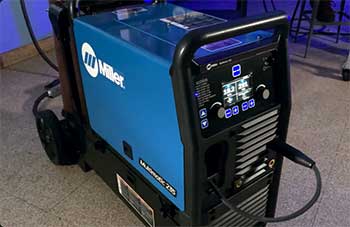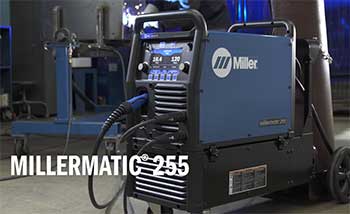If you’re in the market for an auto-set MIG welder that provides versatility for tackling projects on steel, stainless steel or aluminum, the Millermatic 235 and Millermatic 255 are two great options to consider. These high-performing yet easy-to-use welders have a lot of overlap in key specs and capabilities, but also some important differences when it comes to portability, power, duty cycle and overall weld quality.
Understanding the pros and cons around factors like amperage range, materials welded, portability, and control options will help clarify which model suits your needs as either a DIY home gamer, hobbyist, or professional looking to get work done efficiently. Below we’ll compare the millermatic 235 Vs. 255 welders across these areas so you can determine the better buy.
Brief Comparison Table
| Feature | Millermatic 235 | Millermatic 255 |
| Max Material Thickness | Up to 1/4″ steel | Up to 3/8″ steel |
| Max MIG Welding Amps | 210A | 250A |
| Duty Cycle Rating | 34% @ 150A | 60% @ 200A |
| Weight | 63 lbs | 133 lbs |
| Advanced Controls | No | Yes (4 knobs) |
| Auto-Set Modes | Steel, SS, Aluminum | Steel, SS, Aluminum |
| Cost | ~$1500 | ~$2,000 |
Key Similarities Between The Millermatic 235 And 255
Before diving into the differences, let’s look at what these MIG welders have in common:

- Auto-Set Feature: This allows you to select material thickness and wire type. The machine automatically makes the needed amperage and voltage adjustments for a simpler setup.
- Smooth Arc Starts: Both models provide a soft, consistent arc start without splatter. This results in higher quality welds, less rework time, and reduced contamination risk.
- Overload Protection: The units automatically shut off power in overload situations, preventing potential damage to sensitive components.
- Thermal Protection: If the machine overheats from extended high-amp use, power shuts off before components sustain damage.
So in basic function and safety features, the Millermatic 235 and 255 are very similar. Now let’s compare them across some key performance factors.
Millermatic 235 Vs. 255: Power And Portability
The Millermatic 235 delivers up to 210 amps of output at a 34% duty cycle. It weighs 63 pounds.
The Millermatic 255 offers up to 250 amps at a 60% duty cycle, but weighs around twice as much at 133 pounds.

What this means for you:
The 235 gives up some peak amp capacity but is far easier to transport between work sites or maneuver into tight spaces. Its lighter weight makes it a good choice if you value portability.
With 50 more amps on tap plus a higher duty cycle, the 255 allows you to work longer when laying down bigger welds on thicker materials. But the bulkier size may hamper your mobility and access.
Materials, Thickness And Joints
235 Capabilities: Designed for 24 gauge up to 1⁄4 inch steel along with thinner gauges of stainless and aluminum. Best suited for lighter fabrication/repair jobs and DIY home projects.
255 Capabilities: Tacks up to 3/8 inch steel plates plus handles thicker stainless and aluminum stock. Ideal for more heavy duty fabrication work, farm/ranch repairs, auto restoration.
Joint Types: Both machines can handle all standard joint configurations – butt, lap, T and corner joints. Their auto-set abilities adjust arc characteristics between steel, stainless and aluminum to optimize performance across materials.
So while there is some overlap in capabilities, the 255 clearly out-muscles the 235 when it comes to thicker sections of common metals.
Control And Adjustability
The Millermatic 235 features a simplified 2-knob control panel design which limits adjustability but speeds setup through the auto-capability.
Alternatively, the Millermatic 255 gives you 4-knob advanced controls allowing for manual fine tuning of the arc when working with specialty alloys or personalizing weld characteristics.
So the 255 model offers experienced welders more customization, whereas the 235 trades some adjustability for out-of-the-box simplicity.
Additional Comparison Factors
Beyond core welding performance, it’s worth noting a few other similarities and differences as you weigh your buying decision:
Cost – With advanced controls and 50 more amps, the Millermatic 255 does carry about a $500 price premium over the 235 model. This greater upfront cost may pay dividends for high usage scenarios.
Generator Compatibility – Both welders can connect to typical 8000W gas-powered generators for mobile site work. This gives you flexibility working outdoors.
Spool Gun Option – An additional spool gun is available for easier aluminum MIG welding. TheMillermatic 235 utilizes a 15 Series gun, while the 255 requires a more heavy duty 70 Series spool gun.
Warranty – You get a solid 3-year warranty on both machine components and workmanship. Miller stands behind these products.
Hopefully mapping out the millermatic 235 and 255 differences helps provide some clarity. Now let’s get into more detail on the pros and cons of each welder.
Also Read: JS Alternators Vs. Mechman: Better High Output Alternator
Millermatic 235 Pros And Cons
Pros
- More portable and maneuverable
- Simplified control panel
- Auto-set makes it very beginner friendly
- Low cost long term ownership
Cons
- Lower amperage capacity at 210A max
- Lower max material thickness up to 1/4 inch
- Less capable on heavy fabrication/repair jobs
- Lower duty cycle rating at 34%
Millermatic 255 Pros And Cons
Pros
- More powerful capability at 250A
- Handles thicker 3/8 inch steel welds
- Better suited for heavy fabrication work
- Higher 60% duty cycle rating
Cons
- Twice the weight at over 130lbs
- Bulky size and gas bottle hamper mobility
- Advanced controls increase complexity slightly
- Higher purchase cost around $500 more
Also watch this!
Frequently Asked Questions (FAQ)
Still evaluating which model suits your welding needs? Here we answer some of the most common questions that arise around the Millermatic 235 and 255 comparison:
The Millermatic 235 has a 25A breaker built-in that pulls up to 6000 Watts during the welding process while drawing up to 19.8A when starting. This allows for ample power while offering voltage protection.
With 250 amps of output, the Millermatic 255 can handle welds up to 3/8 inch thickness on steel and stainless steel stock. Thicker sections of aluminum can also be welded.
No – unlike multiprocess welders, MIG-only units like the Millermatic 255 do not support stick/SMAW welding. You’ll need a MIG gun or spool gun.
Yes, the MM 255 has an auto-set mode for aluminum MIG welding using either the standard MIG gun (up to 3/16″ stock), or a spool gun (up to 1/4″ stock).
Key Takeaways
When choosing between Millermatic models, first consider your mobility needs, typical material thicknesses welded, and welding experience level.
If you prize portability and simplicity, while also working on thinner metals, the 235 excels. Home gamers get an easy-to-use MIG welder for small projects.
Professionals needing more output for heavier fabrication work will benefit from the greater strength and adjustability of the Millermatic 255.
In the end, understanding your own needs and priorities will dictate whether spending extra for more power makes sense, or if the budget-friendly portability of the 235 fits the bill.